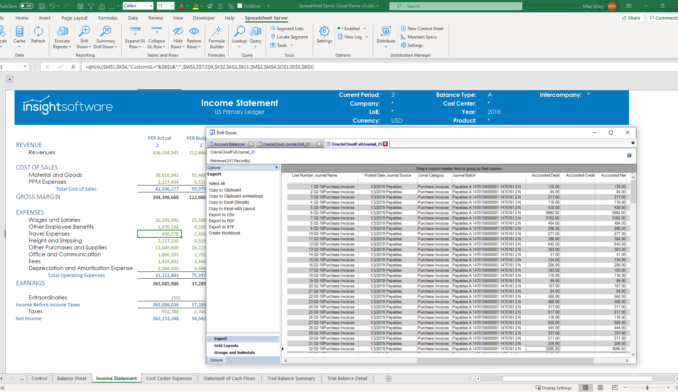Investing in Financial Agility: 4 Tips for CFOs

Disruption is everywhere. Before coronavirus emerged on the scene, business leaders were already facing disruption from technology, regulation, and economic volatility. Emerging technologies have resulted in a wave of innovation that has overturned existing business models. Protectionism has adversely affected some sectors of the economy while benefiting others. A growing cybercrime industry has made it more important than ever to follow sound security practices.
In the midst of disruption, agility matters.
Nothing in our lifetime has disrupted the economy quite as quickly or as impactfully as the coronavirus. For business leaders, it has underscored the critical importance of financial agility. The ability to act fast to assess the situation and take corrective action will be the difference between life and death for many small and mid-sized businesses during the coming year.
Agility is not just about reacting to change, though. It is also about seeing and acting on opportunities. First-mover status can make or break a business initiative, and most opportunities offer a limited window in which to act. Successful business leaders must be able to assess a situation quickly, create a viable plan of action based on realistic data, and execute with velocity.
1. Define Your North Star
According to KPMG’s Sanjay Sehgal, the path to financial agility starts with a vision. He advises finance and accounting leaders to define a “North Star” that establishes where they want their organization to be in one year, three years, or five years. To build an effective plan for achieving that vision, the F&A team will need to look at this challenge from multiple angles. What skills will be needed? What new technology will be required? How do we get from point A to point B?
It is often said that entrepreneurs can get stuck working on tactical execution; that is, working “in the business” rather than operating from a strategic perspective and working “on the business.” The same is true of finance leaders: They need to operate with the understanding that their North Star vision is strategic, and it requires an allocation of their time and investment in resources.
In the past, finance teams were sometimes viewed as record-keepers and compliance managers. Today, finance belongs in the C-suite because it plays a critical strategic role in the business. Agility is a key element in finance’s role as a strategic player in the organization.
2. Shorten the Information Gap
Agility requires fast access to information. Unfortunately, the management teams of most companies have come to expect a built-in delay between the time something happens in their business and the time it becomes visible in a report. Let’s imagine, for example, that the CEO would like to understand the overall impact on cash flow if the sales of restaurant supplies drop by 40 percent over the next quarter. That kind of forecast might require sales pipeline information from the CRM system, a list of outstanding purchase orders from ERP, and a status quo cash flow analysis from a static Excel spreadsheet.
In most businesses, it takes considerable time and effort for an analyst to seek out all of that information, compile it, validate it, analyze it, and return with an answer. Most organizations are using separate systems for ERP, CRM, and dedicated functions such as billing, so getting the answers to such questions can get complicated very quickly.
Financial agility requires a different approach. Innovation happens when leaders ask “what if” and “why not” questions. What if we could shorten the time it takes to get answers to questions like the one that the CEO has asked about cash flow? Why not set a target of cutting that time by 75 percent?
By setting ambitious but achievable targets, finance leaders have an opportunity to develop a culture of agility that will serve the business well during turbulent times.
3. Use Rolling Forecasts and Scenario Planning
Best practices call for periodic forecasts throughout the organization. These include sales and production forecasts, cash flow projections, and pro forma statements. A financially agile organization, however, should be prepared to update forecasts more frequently and even revise them daily. This is a problem for many organizations, though, because forecasts are still assembled the old-fashioned way.
Times like this also call for frequent use of scenario planning. By presenting financial models based on multiple options or potential situations, finance leaders can inform the entire C-suite team in better decision making. The faster and more efficiently these models can be produced, the better. They, too, need to be updated frequently based on what’s currently happening in the business.
Unfortunately, the process of cobbling together static spreadsheets with data residing in multiple systems is tedious, and it often results in errors. To make matters even worse, manually built reports are outdated as soon they are created. Without real-time links to source data, cut-and-paste static Excel spreadsheets can only tell a story of what has happened in the past.
There are very good reasons why most finance professionals love working in Excel. Spreadsheets are simple, flexible, and very powerful. Excel is a natural fit for a wide range of reporting needs, simply because it is so familiar to F&A professionals. By adding real-time links and formulas that securely access data from the various business systems your organization uses, insightsoftware turns Excel into a real-time reporting tool.
Financial agility demands that decision-makers have access to the latest information. Real-time reporting is the only viable option for businesses striving to adapt quickly in a disruptive world.
4. Empower Your End-Users
Every business has its standard catalog of reports. The Sales Manager wants to see an updated pipeline. The Controller wants to know what the cash flow outlook is. The Purchasing Manager wants to see the latest MRP reports. Those are all standard fare, but a financially agile organization must be able to produce ad hoc reports on short notice. F&A teams must be prepared to answer questions that fall outside of the standard set of metrics that business managers see on a day-to-day basis.
In many organizations, the finance team is still dependent on the IT department or outside consultants when they need a new report. Such dependencies cause delays. Financial agility calls for empowering end users to build and modify reports without outside help.
The journey to financial agility need not be a long one. It does require foresight, however, as well as dedicated attention and an investment in resources. The results will be worthwhile, as it will help your organization adapt quickly and navigate through turbulent waters.
Looking to improve your agility during the coronavirus pandemic? Ensure business continuity during the COVID-19 crisis with tips from our Resource Center.








